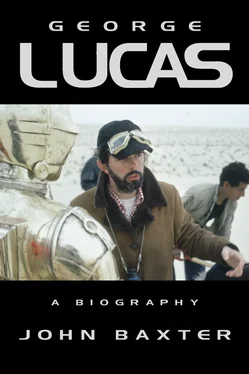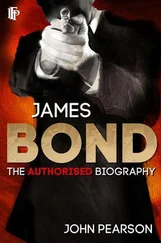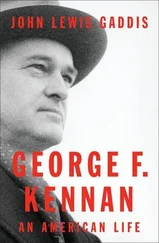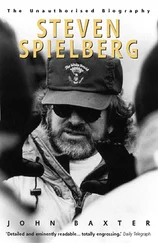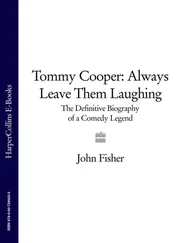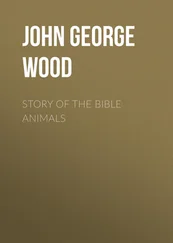In May 1970, the Warners brass demanded to see THX1138 . The day before Coppola was to take the first rough copy to Hollywood, Walter Murch screened it for him. ‘Well, it’s either a masterpiece or masturbation,’ Coppola sighed. That night, he called Murch, Matthew Robbins, and cameraman Caleb Deschanel to an emergency meeting. He’d decided the screening would be a disaster, and briefed them accordingly.
In Warners’ Theater ‘A’ next morning were president Ted Ashley, production head John Calley, Richard Lederer, head of marketing, Frank Wells from business affairs, and the studio’s day-to-day liaison man with Zoetrope, Barry Beckerman. As expected, they loathed the film. ‘This isn’t the screenplay we said we were going to do,’ complained one. ‘This isn’t a commercial movie.’ Coppola feigned ignorance: ‘I don’t know what the fuck this is.’ As they walked out of the theater, talk was only of taking the film away from Lucas and recutting it.
Outside, Murch, Robbins, and Deschanel, as ordered by Coppola, were waiting near the foot of Warners’ landmark watertower. As the executives and Coppola emerged from the front door, they burst into the projection box, claiming to be from the studio editorial department, grabbed the film, loaded it into the back of Robbins’s van, and drove away.
Kidnapping the work print only delayed the inevitable. Warners put Fred Weintraub, its ‘youth’ expert, in charge of cutting THX1138 , and Frank Wells dictated what should be done. Weintraub was convinced that the Shelldwellers, as the film’s only ‘creatures,’ must appear in the first reel. ‘If you hook the audience in the first ten minutes,’ he told Lucas, ‘they’ll forgive anything. You gotta put your best stuff up front … Put the freaks up front.’
In the midst of these discussions, the original THX1138 4EB , now with the added subtitle Electronic Labyrinth , was included in Take One , three programs of student films, half of them from USC, shown in New York, a fact which gave Lucas a melancholy satisfaction. If the feature version never saw the light of day, at least his first draft would survive.
Lucas and Coppola continued to meet in San Francisco, and to discuss the fate of Zoetrope. To add to its problems, the company was embroiled in a complicated lawsuit brought against local unions by the left-wing film-makers to whom Coppola had incautiously given house room the previous year. They’d formed their own union, and Zoetrope’s productions, such as they were, became the battlefield on which they struggled for jurisdiction. It cost Coppola another $40,000 to extricate himself from the firefight.
Patton brought Coppola numerous offers from Hollywood to script and direct films, but he turned all of them down. The most insistent came from Paramount, who wanted him to film Mario Puzo’s bestselling novel The Godfather . Coppola thought it a potboiler, and refused repeatedly. Eventually Peter Bart, a Paramount staffer and, later, editor of the trade paper Variety , rang one last time.
Lucas was in the office that day, and Coppola, covering the mouthpiece, asked, ‘George, what should I do? Should I make this gangster movie or shouldn’t I?’
‘Francis, we need the money,’ Lucas said. ‘And what have you got to lose?’
While Coppola was away filming The Godfather , Lucas moved into the Zoetrope offices. He was constantly on the phone, setting up American Graffiti and finding editing work for Marcia. None of the calls were on behalf of Zoetrope, so after a few weeks office manager Mona Skarger presented him with a phone bill for $1800. With only $2000 in the bank, Lucas had to borrow the money from his father. He was so angry and humiliated that he shunned the offices and sent Marcia in with the check. Coppola later claimed he hadn’t authorized Skarger to demand payment: ‘I would never have done that to a friend.’ Lucas didn’t believe him. Their friendship inched one step nearer a break, though really it was just another aspect of the general withdrawal from personal relationships which paralleled Lucas’s abandonment of Los Angeles. ‘George feels,’ says Willard Huyck, ‘that he made enough friends at USC, and doesn’t need any more.’
One new friend Lucas did accept was a calm, indeed grave young man a few years older than himself named Gary Kurtz. Kurtz wore his beard even shorter than Lucas’s, and cut it back severely from his chin in a style usually associated with the Amish. In fact, Kurtz was raised as a Mormon, and refused to fight in Vietnam from religious conviction. Having graduated from the USC film school in 1962, he was made a combat cameraman with the Marines and served three years ‘in country.’
Kurtz was the same age as Coppola, whom he knew from their days with Corman, but in his gravity, stability, and morality the direct antithesis. ‘I worked for Roger Corman as a student on lots of little films,’ he says, ‘most of which I can’t even remember the titles of now; some of which we didn’t even know the titles of then. Shooting little bits and pieces. That’s how I met Francis. I was on Dementia 13 , his first film. He shot most of it in Ireland but we did little bits of it in Los Angeles.
‘When I got out of the Marines in 1969, I went back to doing a few low-budget films and doing odds and ends, and another friend of mine whom I’d worked with with Roger, Monte Hellman, wanted to do this film, Two Lane Blacktop . We got Universal to buy into it under their under-$1 million-budget program. I went up to talk to Francis about using his Techniscope equipment for Two Lane Blacktop . He said, “We’ve just finished shooting this film on Techniscope. I’ll take you out to meet George, and he’ll show you some of the material on the Steenbeck.” We went out to Mill Valley. George was editing in his attic. He was very gracious. He showed me the footage, and we had a chat about Techniscope, and I went back to San Francisco. I called George a couple of other times about technical aspects of using Techniscope in the next week after that.’
Aside from Radioland Murders and American Graffiti , Lucas had one more idea: a science fiction story, a movie comic-book inspired by Edgar Rice Burroughs, the Flash Gordon serials and Dune , but shot in a style inspired by old Hollywood action films. At some point, wearying of turning images into words, he created an outline in collage, with images cut from comic books and science fiction magazines.
Lucas didn’t aspire to compete with Hollywood science fiction like Forbidden Planet or Planet of the Apes . Another kind of science fiction film had always existed parallel to them. This strain was disreputable, catchpenny, its plots vulgar, its costumes cheap. It encompassed Ed Wood’s Plan Nine from Outer Space , Roger Corman’s The Beast with a Million Eyes and Attack of the Crab Monsters , and Japanese imports like Godzilla . Its market was revival houses or drive-ins, its audience teenagers with one hand up their girl’s skirt and the other clutching a Coke.
Whenever Hollywood got more money for a science fiction film, it splurged on state-of-the-art special effects, good mainstream writers, well-known stars. Forbidden Planet was directed by the director of Lassie Come Home . Its scriptwriter wrote Tarzan the Ape Man . Its cameraman photographed Ernst Lubitsch’s The Smiling Lieutenant . It starred Walter Pidgeon, one of MGM’s oldest and most respected leading men. To do what Lucas proposed with his science fiction film, i.e. spend money not on making the product more intellectually respectable or scientifically authentic, but on amplifying the sleaziness and vulgarity, seemed absurd to Hollywood. One might as well take some cheap old car, give it a lustrous paint job, and tart it up with chrome and flashing lights …
Читать дальше
